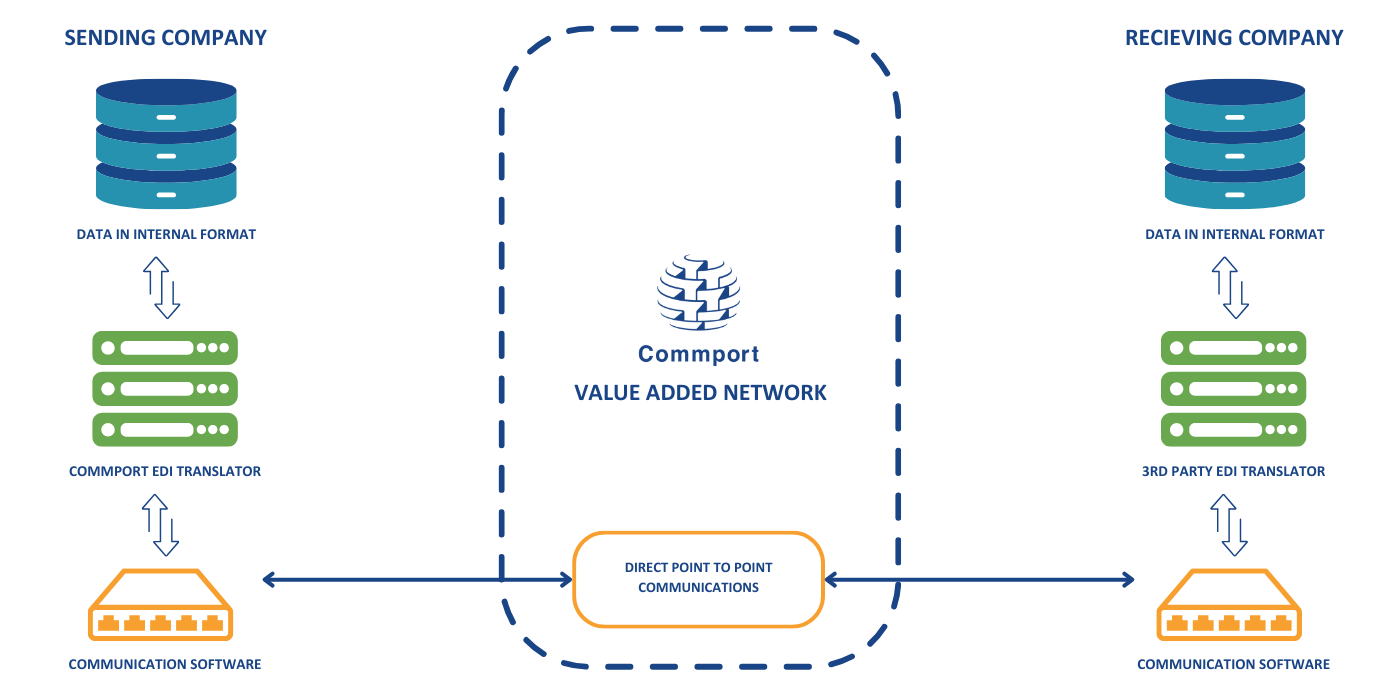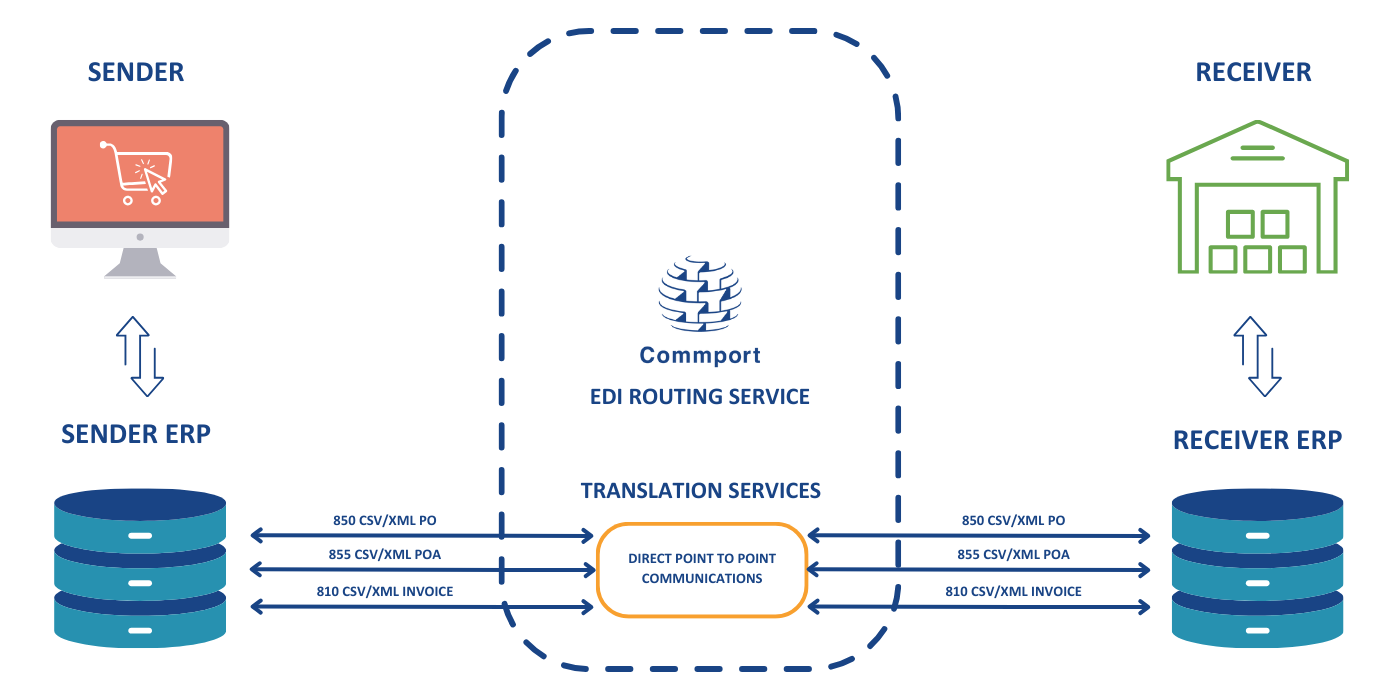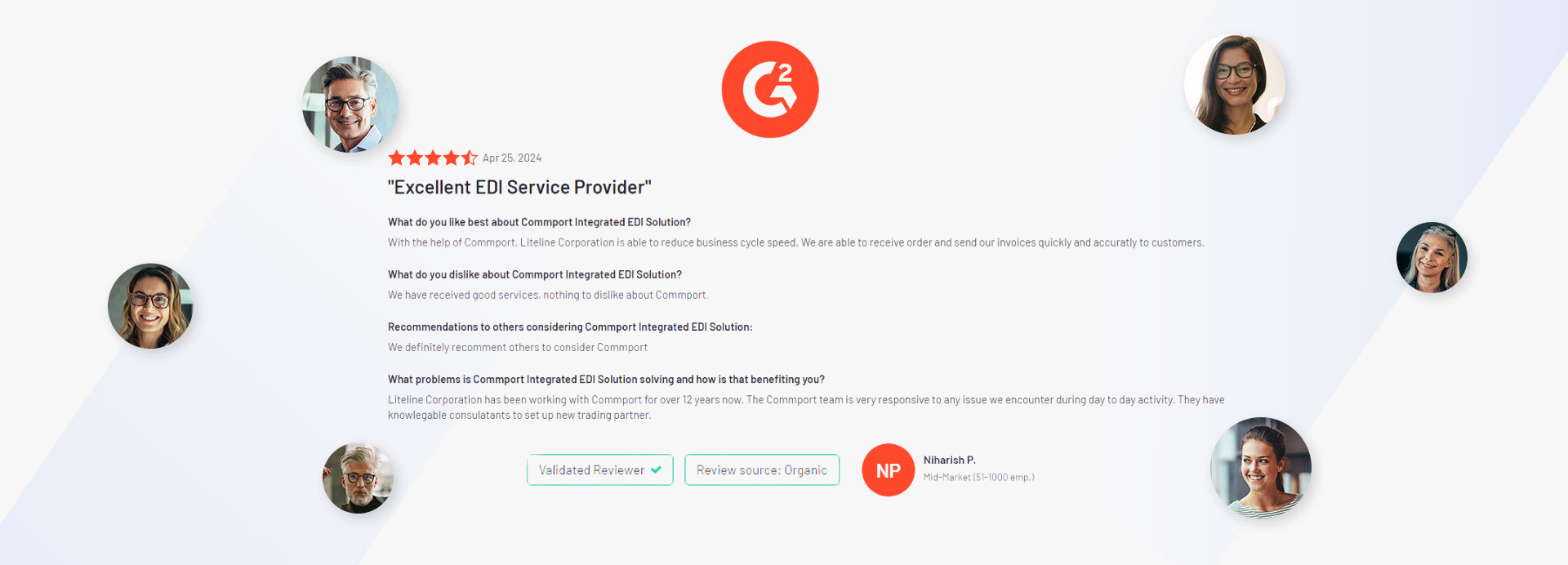Commport Integrated EDI solution enables businesses to transmit documents such as purchase orders, invoices, shipping notices, and other transactions electronically, in a standardized format. This includes document mapping, translation, validation, and communication protocols. It integrates with all ERP systems.

Manual data entry can lead to slower order fulfillment and increase operational expenses by 20-30%, + up to an additional 20% in chargebacks due to data processing errors.
Managing manual workflows often leads to significant roadblocks, such as:
Misalignment between internal systems and partner data causes delays and errors.
Integrating with internal systems can be challenging and resource-intensive.
High dependence on manual processes increases errors and slows workflows.
Adapting to larger transaction volumes or expanding partner networks can strain resources.
Minimal automation leads to inefficient, repetitive tasks and higher costs.
Inadequate tracking and monitoring of transactions hampers decision-making.
These inefficiencies can hinder your ability to scale and collaborate effectively. Commport Integrated EDI connects your EDI directly with your business systems, enabling seamless, automated workflows and improved transaction accuracy.
Commport's Integrated EDI facilitates efficient data exchange, enabling businesses to effectively collaborate with partners and automate critical business processes.

Commport’s Integrated EDI solution enables businesses to transmit documents such as purchase orders, invoices, shipping notices, and other transactional information electronically, in a standardized format, without the need for manual data entry. This includes document mapping, translation, validation, and communication protocols. It integrates with all ERP (Enterprise Resource Planning) systems, and supports EDI standards such as ANSI X12, EDIFACT, EANCOM, RosettaNet, ODETTE, and TRADACOMS, providing businesses with a secure and efficient means of exchanging information with their trading partners. It can integrate with other business applications, such as inventory management, order processing, and shipping systems, creating a seamless flow of information between different departments and systems.
Commport’s EDI solutions enable businesses to establish secure and direct connections with their trading partners eliminating the need to run on premise EDI translation software and reduces communication costs.
Unlock efficiency and enhance your supply chain with our Integrated EDI Solution—say goodbye to manual processes and multiple systems. Learn all you need to know about Integrated EDI and make an informed choice.
Just some of the many benefits to implementing Integrated EDI within your business operations
Utilizes standardized document formats to ensure consistency and compatibility between trading partners. These formats define the structure and content of business documents, including purchase orders, invoices, shipping notices, and more. Standardization eliminates the need for custom integrations and enables efficient document exchange across industries and geographies.
Automates the exchange of business documents, eliminating manual processes. It enables real-time, machine-to-machine communication between systems, streamlining supply chain operations and improving overall efficiency. By automating data exchange, businesses can significantly reduce processing time, enhance accuracy, and improve productivity.
Eliminates the costs associated with paper-based processes, such as printing, postage, and manual document handling. With EDI, businesses can minimize the need for physical storage space, reduce administrative overhead, and improve overall cost efficiency.
Eliminates the risks of manual data entry and the associated errors. By electronically exchanging data in a standardized format, EDI ensures data integrity and accuracy throughout the document exchange process. This reduces the likelihood of misunderstandings, discrepancies, and rework caused by manual data entry errors, leading to improved overall data quality.
Provides real-time visibility into the status and progress of business transactions. Trading partners can easily track the movement of documents, such as purchase orders and shipment notifications, enabling proactive decision-making and timely responses. This enhanced visibility promotes better collaboration, reduces delays, and improves supply chain transparency.
Accommodates the growth and changing needs of organizations, allowing them to seamlessly onboard new trading partners and adapt to evolving business requirements. EDI also integrates with various internal systems, such as enterprise resource planning (ERP) and warehouse management systems (WMS), enhancing interoperability and data flow.
Helps businesses meet industry-specific regulatory requirements and standards. For instance, in sectors like healthcare and retail, EDI supports compliance with the GS1 standards. By adhering to these standards, businesses can ensure regulatory compliance and streamline processes related to data security, privacy, and product identification.
Enables seamless communication and document exchange between trading partners across borders. It supports multilingual capabilities and caters to global business requirements. With EDI, businesses can easily engage with international trading partners, ensuring smooth cross-border transactions and fostering global business collaborations.
Get the benefits of EDI at a price that fits your budget. Explore Commport’s affordable, scalable solutions and start simplifying your data exchange today!
Commport Integrated EDI Solutions streamline business communications by seamlessly connecting trading partners, automating data exchange, and enhancing supply chain efficiency. With Commport’s robust EDI platform, you gain real-time visibility into transactions, simplified compliance with trading partner requirements, and secure data exchange across industries. Our solution supports multiple EDI formats, offering flexible integration with your existing systems for a customized experience that grows with your business. Backed by dedicated support and expertise, Commport Integrated EDI ensures your data flows smoothly, helping you reduce costs, avoid errors, and improve overall productivity.
EDI translation services play a crucial role in enabling seamless communication between businesses

EDI translation services refer to converting electronic business documents from one EDI format to another. Businesses often use different EDI standards and formats based on industry requirements or partner preferences. These standards include ANSI X12, UN/EDIFACT, Tradacoms, and more. When two businesses with different EDI systems need to exchange information, they may require EDI translation services to ensure seamless communication.
The incoming EDI message is broken down into its individual data elements, segments, and loops. This process involves identifying the different parts of the message and extracting relevant information.
The extracted data from the source EDI format is then mapped to the equivalent data fields in the target EDI format. This step requires a predefined mapping configuration that defines how data should be transformed and aligned between the two formats.
Once the mapping is established, the actual translation process takes place. Data is transformed from the source format to the target format according to the predefined rules. This ensures that the data retains its meaning and integrity during the conversion.
The translated EDI document is validated to ensure that it adheres to the standards and requirements of the target format. This involves checking for syntax errors, missing data, and other issues that could hinder successful communication.
In some cases, additional information might need to be added to the translated document to meet specific business rules or regulations. This could involve calculating totals, adding timestamps, or including partner-specific information.
Once the translation and validation are complete, the EDI translation service generates the final EDI document in the target format. This document is then ready to be sent to the intended recipient.
After the translated document is sent, the receiving party may send an acknowledgment (often an EDI acknowledgment document) to confirm the successful receipt of the message. This step helps ensure the accuracy and completeness of the data exchange.
Unlock the full potential of your supply chain with our comprehensive EDI Buyer's Guide — your first step towards seamless, efficient, and error-free transactions
Commport offers a number of EDI solutions to help you increase your business efficiencies

Acts as a single communications link to multiple trading partners, enabling the exchange of business documents

Empowers you to begin exchanging EDI with your trading partners today… all you need is an internet connection!

Let Commport manage ALL aspects of your EDI relationships for you (trading partners/retail partners, etc.)




Discover the transformative impact of our EDI, VAN, and GDSN solutions through the powerful testimonials of satisfied clients who have experienced remarkable results with Commport products and services.








An Integrated EDI solution translates your inbound documents, like purchase orders, from your trading partners’ EDI files into a format that can be imported directly into your ERP, accounting or other business system.
Integrated EDI Software takes the format exported from your system and translates it into the EDI formats required by your trading partners.
Absolutely! Integrated EDI solutions are highly customizable to align with your unique business requirements. Whether you operate in retail, manufacturing, or any other industry, the flexibility of Integrated EDI ensures a tailored approach to meet your specific needs.
Integrated EDI automates data exchange processes, significantly reducing the chances of manual errors. This automation not only enhances accuracy but also leads to cost savings by streamlining operations, minimizing data entry time, and eliminating the need for paper-based transactions.
Integrated EDI is adaptable and scalable, making it suitable for businesses of all sizes. Whether you’re a small startup or a large enterprise, Integrated EDI can be tailored to fit your scale and grow with your business needs. Its versatility ensures it’s a valuable asset for businesses across different sizes and industries.